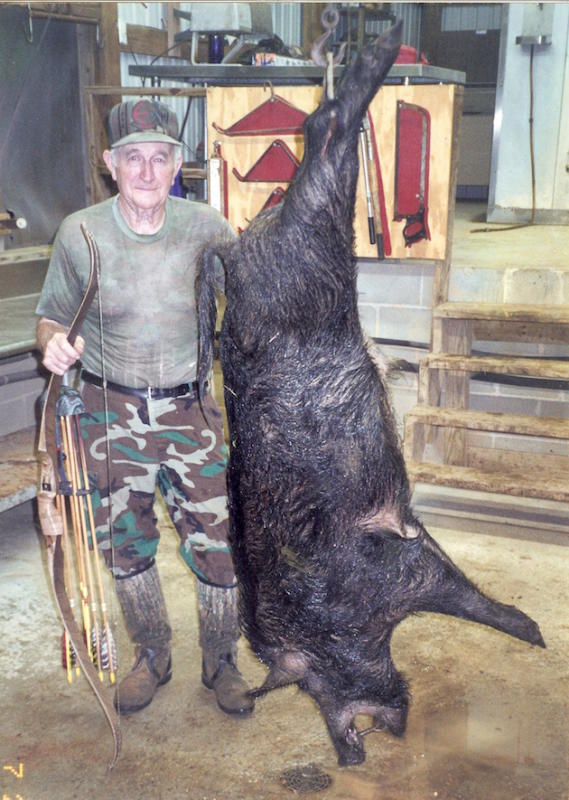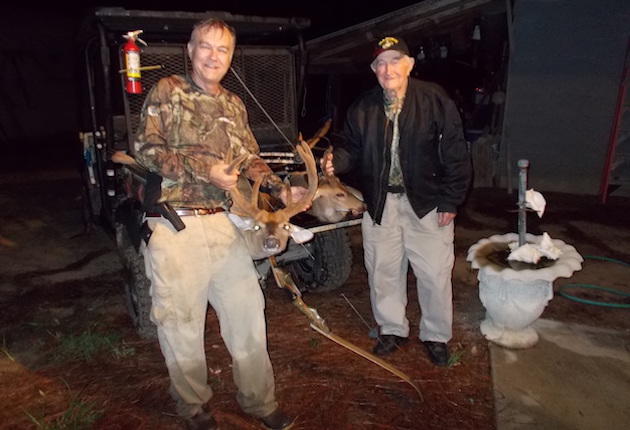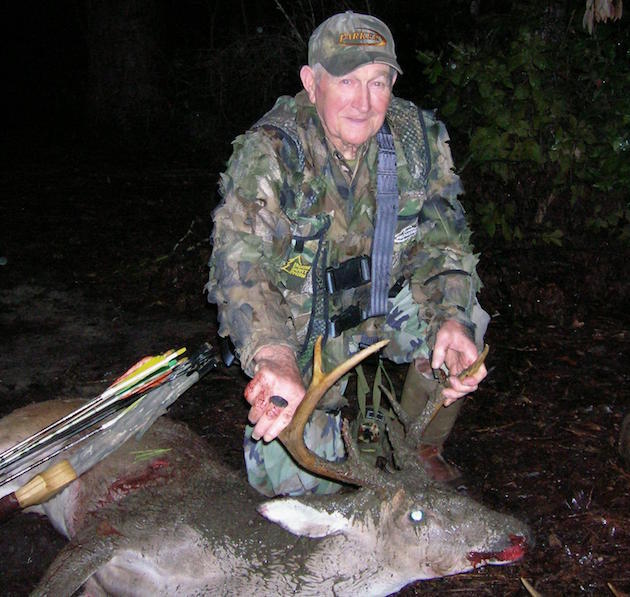Owen Jeffery, a living legend in American archery and bowmaking who invented many of the innovations now standard in modern bows, died in Columbia, S.C., on March 18. He was 91.
Although he preferred to hunt with a simple recurve bow, Jeffery, a contemporary and hunting companion of the famed Fred Bear, was recognized as one of the major innovators in modern archery equipment. During his 66 years in the archery business, Jeffery was a world-renowned Master Bowyer who held multiple archery tournament championship titles. A charter member of the Professional Archers Association, Jeffery was recently nominated to the Archery Hall of Fame.
Jeffery became fascinated with the ancient weaponry as a boy in Arkansas. He fashioned his first bow from a red cedar limb and tied chicken feathers on a piece of cane for an arrow. He killed his first deer with a bow when he was 12 years old.
As a competition archer, Jeffery won numerous championships. He was a six-time Missouri State Champion, Midwestern Champion in 1954 and 1955, National Broadhead Champion in 1961, and Southern Regional Champion in 1962.
“I didn’t learn to shoot from books,” Jeffery said. “I developed the hand-eye coordination by doing it over and over.”
That included popping coke bottles with a homemade hickory bow whiled stationed on New Hebrides Island in the South Pacific during World War II. A Marine Corps veteran, Jeffery was a crew chief on B-25 bombers. After the war he hunted rabbits with a bow, leading his neighbors to nickname him “Robin Hood.”
In the early 1950s Jeffery joined the Hoyt Archery Company in St. Louis as a bowyer. While at Hoyt, he designed and built the world’s most accurate target bows. The top archers of the day used his bows to win national and world archery titles.
He developed the first pistol-grip bow handle, which was patented by Hoyt. He also created the first bow stabilizers, which revolutionized bow stability, then he developed the torque flight compensator, allowing the bow to move smoothly out of the way of the arrow. Today’s flexible stabilizers, also patented by Hoyt, are a direct result of Jeffery’s creative genius, as are all the improvements in the use of fiberglass and other materials developed over the past half century.

Owen Jeffery with a massive South Carolina hog he took with a recurve.
In 1966 Jeffery joined the Bear Archery Co. in Michigan, where he was president of manufacturing and hunted and fly fished with Fred Bear. There he designed many of the bows that the legendary Fred Bear hunted with and produced for the archery public, including the famous Fred Bear Takedown Bows, Super Kodiaks, and Kodiak Magnums.
Jeffery also developed Bear’s first compound bow, the Alaskan. The compound bow, which distributes energy via a system of cables and offset wheels, revolutionized bowmaking. For the first time, a shooter could draw his bow, aim, and hold the arrow until the perfect moment to shoot — without fighting the pull of the bow.
In 1973 Jeffery moved to Columbia, S.C., as head of the Shakespeare Company’s Archery Division. Three years later, when Shakespeare divested several divisions, including archery, he established Jeffery Archery in Columbia. He designed and built all the presses and other equipment used in making bows in the company’s manufacturing area.
“As a bowmaker and innovator, he had an innate mechanical genius,” said Jeffery’s son, Tom, who runs Jeffery Archery today. “He understood the mechanics of how the bow and arrow actually worked and could visualize that in his mind. With that understanding, he was able to do all those things with a bow, whether shaping it into an elegant instrument or doing things with various materials to maximize and produce the results he sought.
“When you add in his innate artistic talent, he was able to create a beautiful product as well as one that functioned perfectly.”

Jeffery and his son Tom, left, with a traditional archery buck.
Although Jeffery Archery carries major archery brands, the company specializes in traditional archery equipment, creating longbows and recurves for both competition archers and camo-clad bowhunters. Jeffery Archery has produced custom bows for governors and stylized archery equipment for princes and presidents, from the King of Butan to the president of Mexico.
Jeffery’s skills as a teacher were in great demand over the years. He built bows for and coached U.S., Russian, and Japanese Olympic archers and made bows for Indonesian and Australian Olympic archers. In 1978 he was invited by the French government to train the French Olympic archery team at the Paris Institute for Sports.
In 1961, when Jeffery became a charter member of the Professional Archers Association, he was one of only four master coaches in the organization who trained competition shooters in a professional archery school. He was also sought over the years as a speaker for various groups, from Cub Scouts to grizzled bowhunters.
“He had a speaking manner that engaged his audiences whether they were 6 or 60, inspiring them for an understanding and respect for the bow and arrow,” said Tom, who usually accompanied his father and assisted with archery demonstrations.
In the 66 years that Jeffery designed and built bows and taught thousands of archers to to shoot accurately, he maintained his base passion to the end: bowhunting for whatever was in season, from white-tailed deer and wild hogs to rabbits. Even field mice.
In 1963 Jeffery arrowed a 308-pound, 12-point whitetail buck on an island in the Mississippi River. A record book buck at the time, the mount hung in the Fred Bear Museum in Gainesville, Fla., for many years. He looked forward to the opening of deer season each year in South Carolina, but he honed his skills until then hunting wild hogs, which have no closed season with bow and arrow. He took his last deer at the age of 88 with, reluctantly, a crossbow, because he was no longer physically able to pull a regular bow.
“He was a tireless ambassador for the sport of archery and hunting,” said Tom. “He instilled his interest in the sport in literally thousands of people who took up hunting with bow and arrow, many of them simply because he introduced them to the game.”
Photos courtesy of Tom Jeffery


There are a few people who truly love what they do for there work or sport, he was a man of passion who loved to teach what he loved about archery, My family and I are glad to have got to know him and spend time on the jug course at Pepper st., learning from the master.. He will be missed,,
If Mr. Owen had been around to make bows for the Indians, America would likely be much different. When he spoke, he really captured the audience’s attention. I can vividly remember, after 20 years, Mr. Owen telling my friend and I about a hog hunt. He was truly a legend.
He was one of the last of a dying breed of men. My dad has spoken very fondly over the years of having the pleasure of working with him at Shakespeare, shooting field archery tournaments and hunting trips of years gone by. A great man treasured by many will be greatly missed .
Owen was just as accomplished with a Sling Shot as he was a Bow. I, along with Bill Ramsey donated our labor on weekends, installing some of the machinery Owen bought from Shakespeare when it closed the Archery Division. I numbered and cataloged the equipment for the auction. Owen was also an accomplished Light air craft Pilot.
Owen was a great inspiration to me and Tom and the team have been great friends and ambassadors of the sport.
Owen was so kind to my husband when he started bow hunting years ago. He will always cherish the bows Owen made for him. RIP Owen . You will be missed by many!
A great loss of a great man he will be missed by the archery world
Loved this man
Owen Jeffery was and will remain a legend to me. I worked for him for two years after high school and throughly enjoyed the experience. He taught me skills that I have used many times over in my life. He was so much fun to be around. He always had some joke or prank to pull on us in the shop. He will truly be missed by many. Long live the legend! RIP Owen!
Such a kind and great man!
Spent many hours talking to him!
You will be dearly missed my friend!
A very kind man. I always enjoyed talking to him.
I had the pleasure of meeting Jeffrey several years back. He was very kind, and humble. My condolences to his family.
I met Owen Jeffery at Jeffrey Archery in Columbia a few years ago. He was very gracious and we spent almost an hour together talking about bow hunting and bows. I own two of the Jeffrey designed Bear Takedown bows which I proudly displayed to Mr. Jeffrey and his son Tom. Of course we took pictures , a video, and I got an autograph which I will always cherish. Thank You Owen Jeffrey for all you did for Bowhunting and Archery throughout your life. RIP. Doug Williams, Sautee, Georgia.